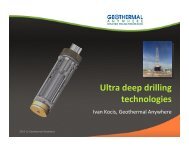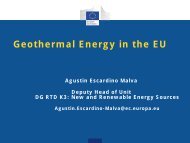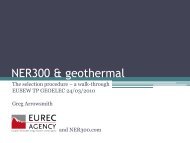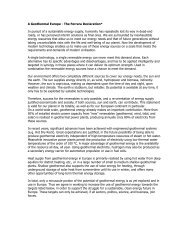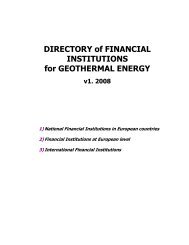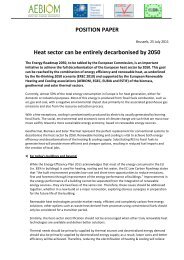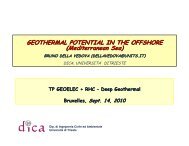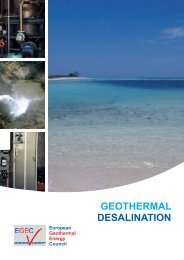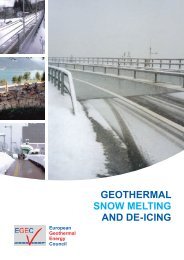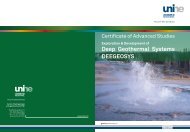5<strong>Strategic</strong> <strong>Research</strong> <strong>and</strong> <strong>Innovation</strong> <strong>Agenda</strong> <strong>for</strong> <strong>Renewable</strong> Heating & CoolingRHC applications to industrial processes5.3.1 <strong>Research</strong> <strong>and</strong> innovation priorities with impact in the Short TermR&D activities on biomass technology <strong>for</strong> industrial heating <strong>and</strong> cooling should focus onimproving efficiency of large-scale plants <strong>and</strong> decreasing their carbon footprint. Taking intoaccount the increasing emissions st<strong>and</strong>ards <strong>and</strong> the limited availability of high quality woodresources in Europe, significant R&D ef<strong>for</strong>ts are required to develop high-efficient loadflexiblemulti-fuel systems. Fuel supply will become a crucial issue <strong>and</strong> R&D activities shouldthere<strong>for</strong>e always consider the chain integration.Tri-generation with biomass presents various advantages which make it an interestingsolution in different energy systems. Biomass is storable renewable energy <strong>and</strong> can be used<strong>for</strong> regulating electricity production. Moreover, biomass can be used <strong>for</strong> heating, cooling <strong>and</strong>electricity production with system efficiency of up to 85%.BIO.9ObjectiveDevelopment of highly efficient large-scale or industrial CHP with enhancedavailability <strong>and</strong> high temperature heat potentialThe aim of this priority is to increase the steam data, i.e. pressure <strong>and</strong> temperature(advanced steam data), from 540°C to 600°C <strong>for</strong> 100% biomass-fired plants. Biomass<strong>and</strong>/or biomass co-firing power plants should increasingly utilise waste heat <strong>for</strong> industrialheat utilisation. Alternative technology options, e.g. biomass gasification <strong>and</strong> indirect co-firing,should be investigated. Process adaptations of fuel pretreatment are required, e.g. torrefactionto reduce alkaline content of biomass <strong>and</strong> improve grindability 60 . Corrosion, fouling <strong>and</strong> agglomeration(in Fluidised Beds (FBs)) from alkali metal chlorides <strong>and</strong> heavy metals (Pb, Zn, etc)in biomass-fired plants <strong>and</strong> co-firing units should be reduced by:• R&D of new materials (austenitic alloys, Ferritic alloys, FeCrAl alloys, Ceramics) suitable<strong>for</strong> combustion of problematic biomass types, tackling problems such as creeping, cracking,Thermal Mechanical Fatigue (TMF) , corrosion, erosion, fouling;• Development <strong>and</strong> testing of new additives that result in the <strong>for</strong>mation of less corrosivesubstances: (i) sulphur containing additives: ammonium sulphate, elemental sulphur, sulfurgranules, (ii) phosphorous containing additives: dicalcium phosphate, monocalium phosphate<strong>and</strong> (iii) AlSi containing additives: kaolin, dolomite, bentonite;• Development <strong>and</strong> testing of suitable co-firing matrices <strong>for</strong> problematic biomass fuels,e.g. co-firing high alkali metal-containing biomass with high sulphur fuels;• Demonstration of new types of boiler design that minimize fouling/corrosion in critical areas,e.g. changes of excess oxygen, flue gas temperature <strong>and</strong> velocities.State-of-the-art CHP units fuelled with biomass only currently reach a net electrical efficiency around 30%<strong>and</strong> this per<strong>for</strong>mance is increased to over 43% <strong>for</strong> co-firing plants. Steam temperature amountto 540°C <strong>for</strong> clean biomass. Thermal shares of agrobiomass <strong>and</strong>/or RDF are limited to 20%<strong>and</strong> in most cases do not exceed 10%. The majority of large-scale plants produce power only,the heat is wasted.TargetsType of activity• Demonstration of a highly efficient (>40 %) steam CHP-plant <strong>for</strong> clean fuel fractionswith enhanced steam parameters (up to 600°C );• Demonstration of a high efficient steam (34%) CHP-plant <strong>for</strong> broader fuel span with enhancedsteam parameters (up to 540°C );• Demonstration of a high efficiency biomass <strong>and</strong>/or co-firing power plant with an agrobiomass<strong>and</strong>/or RDF thermal share of 30%;• Total CAPEX <strong>and</strong> OPEX increase of no more than 5-10% over current state of the art <strong>for</strong>new technologies;• 1-2 demonstrations of power plants producing only electricity converted to CHP units<strong>for</strong> provision of industrial heat;30% Development / 70% Demonstration5.3.2 <strong>Research</strong> <strong>and</strong> innovation priorities with impact in the Medium <strong>and</strong> Long TermBIO.10ObjectiveDevelopment of high efficient biomass conversion systems <strong>for</strong> tri-generation(heating, cooling <strong>and</strong> power)In this R&D priority the main mission is to analyse <strong>and</strong> identify the role of biomass as a“storable RES” within a 100% renewable energy system, particularly in combination withintermittent RES such as solar <strong>and</strong> wind.The new tri-generation operating environment requires new, simultaneous functions <strong>and</strong>capabilities from the biomass CHP-C units: flexible load operation, fuel flexibility as well asoperation in integration with energy storages. Specific technologies to increase the intelligenceof multi-fuel units must be identified <strong>and</strong> developed including on-line fuel quality <strong>and</strong> processmonitoring; as well as introducing fertiliser factories in order to fully recycle the ash-boundbiomass nutrients back to the fields <strong>and</strong> <strong>for</strong>ests.The system analysis requires the development of dynamic models that can simulate the daily<strong>and</strong> seasonal behaviour of urban energy system in different climatic conditions. Dependingupon the season, climatic condition <strong>and</strong> time of day the primary function of such biomass fuelledunits may change from electricity, heating, cooling to even bio-oil production (<strong>for</strong> example withintegrated pyrolysis oil production).60Higher Hardgrove GrindabilityIndex (HGI) in order to makebiomass ‘coal mill ready’. TheHGI was developed as anempirical test to indicate howdifficult it would be to grind aspecific coal to the particlesize necessary <strong>for</strong> effectivecombustion in a pulverizedcoal fired boiler. It can alsobe used <strong>for</strong> torrefied biomass.54
<strong>Renewable</strong>Heating & CoolingEuropean Technology Plat<strong>for</strong>mBIO.10State-of-the-artDevelopment of high efficient biomass conversion systems <strong>for</strong> tri-generation(heating, cooling <strong>and</strong> power)At the moment tri-generation has not been demonstrated on a large scale <strong>and</strong> evenin Nordic counties the yearly efficiency of CHP systems does not exceed 65%.At present neither visionary background documents nor integrated energy technologyassessments including the whole biomass fuel supply chain exist <strong>for</strong> biomass basedtri-generation in combination with intermittent wind <strong>and</strong> solar energy supply. The potential <strong>and</strong>requirements <strong>for</strong> such systems in various energy <strong>and</strong> climatic conditions need to be identified.TargetsType of activity• Energy modelling <strong>and</strong> identification of the requirements of future biomass CHP-C unitsas part of multi-source renewable energy systems.• Demonstrating tri-generation, with concepts <strong>for</strong> different climatic conditions, reaching at least80% average annual efficiency.• Development of innovative concepts <strong>for</strong> cost efficient fertiliser factories in order to recyclebiomass nutrients or recover strategic elements.• Creating test beds <strong>for</strong> on-line monitoring <strong>and</strong> measurement techniques.• Identifying business models <strong>for</strong> two-way tri-generation <strong>and</strong> poly-generation energy networks.20% <strong>Research</strong> / 50% Development / 30% DemonstrationBIO.9<strong>Research</strong> <strong>and</strong> <strong>Innovation</strong> Priorities Predominant type of activity ImpactDevelopment of highly efficient large-scale or industrialCHP with enhanced availability <strong>and</strong> high temperatureheat potentialDemonstration By 2020BIO.10 Development of CO2-negative bioenergy systems Development By 2020Table 12: research <strong>and</strong> innovation priorities <strong>for</strong> biomass applications to industrial processes5.4 Geothermal technologyLow temperature range (‹95 °C), including coolingGeothermal energy can provide heat in the low temperature range as explained in the previoussections of this publication. Because geothermal energy has definite base-load characteristics,<strong>and</strong> is always available when required, it matches perfectly with stable dem<strong>and</strong>patterns of most industrial processes. The annual full-load hours can be rather high, <strong>and</strong>thus the return on investment <strong>for</strong> the geothermal installation favourable. Inthis <strong>for</strong>m, geothermal heat is already used in agriculture/aquaculture (e.g. greenhouses),drying processes in the food industry, etc. Specific R&D needs are not listed here, as theyare equivalent to those in the DHC sector (Chapter 6).Another geothermal technology useful <strong>for</strong> industrial applications is undergroundthermal energy storage (UTES). In particular UTES at 40-90 °C can directly supply heat<strong>for</strong> low temperature industrial needs such as batch processes or seasonal industries(e.g. sugar refineries), where periods of heat (<strong>and</strong>/or cold) dem<strong>and</strong> are followed byphases of inactivity.Geothermal heat can also be used as operating energy <strong>for</strong> absorption chillers, to supplycooling to industrial processes. R&D priorities <strong>for</strong> UTES <strong>and</strong> absorption cooling areincluded among the cross-cutting technologies presented in this Chapter.Medium temperature range (95-250 °C)Geothermal energy can provide heat above 95 °C from deep geothermal resources <strong>and</strong> fromhigh-enthalpy geothermal resources. High enthalpy resources, some of which show temperaturesover 250 °C, are used almost exclusively <strong>for</strong> electric power production. Use of theheat <strong>for</strong> industrial purposes is also feasible. R&D will be required to provide <strong>for</strong> the rightmatching <strong>and</strong> adaptation of the geothermal heat source to the specific characteristics of theindustrial process concerned.For the heat source as such, most R&D needs are the same as <strong>for</strong> deep geothermalin DHC, as long as temperatures below about 120 °C are considered (cf. Chapter 6).As the temperature of the geothermal fluid increases, other problems need to be solved, likedegassing of the fluid (pressure control), corrosion, <strong>and</strong> insufficient pump technology.55



